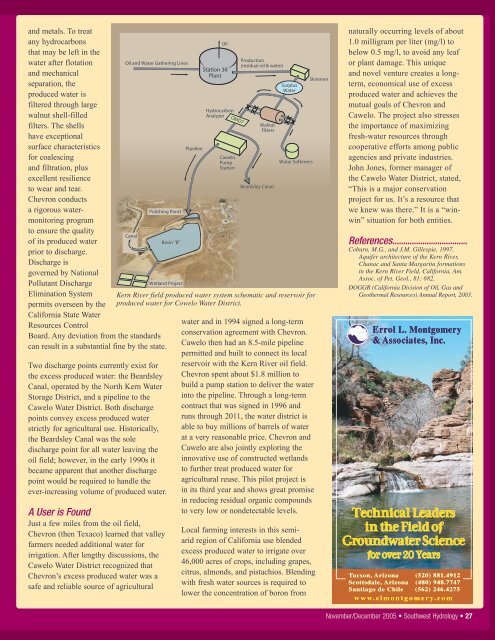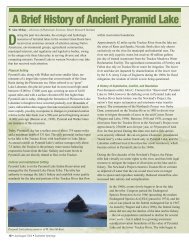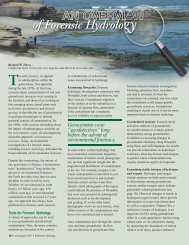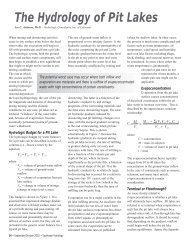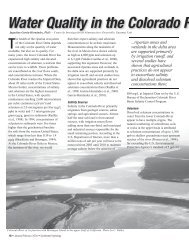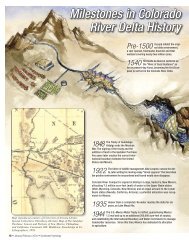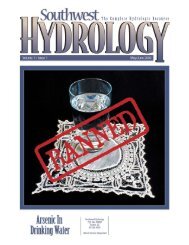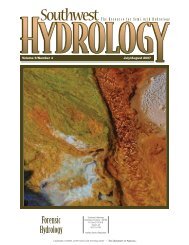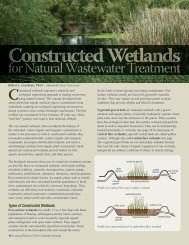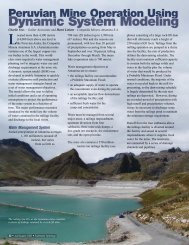Produced Water Reuse at the Kern River Oil Field - Southwest ...
Produced Water Reuse at the Kern River Oil Field - Southwest ...
Produced Water Reuse at the Kern River Oil Field - Southwest ...
You also want an ePaper? Increase the reach of your titles
YUMPU automatically turns print PDFs into web optimized ePapers that Google loves.
and metals. To tre<strong>at</strong><br />
any hydrocarbons<br />
th<strong>at</strong> may be left in <strong>the</strong><br />
w<strong>at</strong>er after flot<strong>at</strong>ion<br />
and mechanical<br />
separ<strong>at</strong>ion, <strong>the</strong><br />
produced w<strong>at</strong>er is<br />
filtered through large<br />
walnut shell-filled<br />
filters. The shells<br />
have exceptional<br />
surface characteristics<br />
for coalescing<br />
and filtr<strong>at</strong>ion, plus<br />
excellent resilience<br />
to wear and tear.<br />
Chevron conducts<br />
a rigorous w<strong>at</strong>ermonitoring<br />
program<br />
to ensure <strong>the</strong> quality<br />
of its produced w<strong>at</strong>er<br />
prior to discharge.<br />
Discharge is<br />
governed by N<strong>at</strong>ional<br />
Pollutant Discharge<br />
Elimin<strong>at</strong>ion System<br />
permits overseen by <strong>the</strong><br />
California St<strong>at</strong>e <strong>W<strong>at</strong>er</strong><br />
Resources Control<br />
<br />
<br />
<br />
Board. Any devi<strong>at</strong>ion from <strong>the</strong> standards<br />
can result in a substantial fine by <strong>the</strong> st<strong>at</strong>e.<br />
Two discharge points currently exist for<br />
<strong>the</strong> excess produced w<strong>at</strong>er: <strong>the</strong> Beardsley<br />
Canal, oper<strong>at</strong>ed by <strong>the</strong> North <strong>Kern</strong> <strong>W<strong>at</strong>er</strong><br />
Storage District, and a pipeline to <strong>the</strong><br />
Cawelo <strong>W<strong>at</strong>er</strong> District. Both discharge<br />
points convey excess produced w<strong>at</strong>er<br />
strictly for agricultural use. Historically,<br />
<strong>the</strong> Beardsley Canal was <strong>the</strong> sole<br />
discharge point for all w<strong>at</strong>er leaving <strong>the</strong><br />
oil field; however, in <strong>the</strong> early 1990s it<br />
became apparent th<strong>at</strong> ano<strong>the</strong>r discharge<br />
point would be required to handle <strong>the</strong><br />
ever-increasing volume of produced w<strong>at</strong>er.<br />
A User is Found<br />
Just a few miles from <strong>the</strong> oil field,<br />
Chevron (<strong>the</strong>n Texaco) learned th<strong>at</strong> valley<br />
farmers needed additional w<strong>at</strong>er for<br />
irrig<strong>at</strong>ion. After lengthy discussions, <strong>the</strong><br />
Cawelo <strong>W<strong>at</strong>er</strong> District recognized th<strong>at</strong><br />
Chevron’s excess produced w<strong>at</strong>er was a<br />
safe and reliable source of agricultural<br />
<br />
<br />
<br />
<br />
<br />
<br />
<br />
<br />
<br />
<br />
<br />
<br />
<br />
<br />
<br />
<br />
<br />
<br />
<br />
<br />
<strong>Kern</strong> <strong>River</strong> field produced w<strong>at</strong>er system schem<strong>at</strong>ic and reservoir for<br />
produced w<strong>at</strong>er for Cowelo <strong>W<strong>at</strong>er</strong> District.<br />
w<strong>at</strong>er and in 1994 signed a long-term<br />
conserv<strong>at</strong>ion agreement with Chevron.<br />
Cawelo <strong>the</strong>n had an 8.5-mile pipeline<br />
permitted and built to connect its local<br />
reservoir with <strong>the</strong> <strong>Kern</strong> <strong>River</strong> oil field.<br />
Chevron spent about $1.8 million to<br />
build a pump st<strong>at</strong>ion to deliver <strong>the</strong> w<strong>at</strong>er<br />
into <strong>the</strong> pipeline. Through a long-term<br />
contract th<strong>at</strong> was signed in 1996 and<br />
runs through 2011, <strong>the</strong> w<strong>at</strong>er district is<br />
able to buy millions of barrels of w<strong>at</strong>er<br />
<strong>at</strong> a very reasonable price. Chevron and<br />
Cawelo are also jointly exploring <strong>the</strong><br />
innov<strong>at</strong>ive use of constructed wetlands<br />
to fur<strong>the</strong>r tre<strong>at</strong> produced w<strong>at</strong>er for<br />
agricultural reuse. This pilot project is<br />
in its third year and shows gre<strong>at</strong> promise<br />
in reducing residual organic compounds<br />
to very low or nondetectable levels.<br />
Local farming interests in this semiarid<br />
region of California use blended<br />
excess produced w<strong>at</strong>er to irrig<strong>at</strong>e over<br />
46,000 acres of crops, including grapes,<br />
citrus, almonds, and pistachios. Blending<br />
with fresh w<strong>at</strong>er sources is required to<br />
lower <strong>the</strong> concentr<strong>at</strong>ion of boron from<br />
<br />
n<strong>at</strong>urally occurring levels of about<br />
1.0 milligram per liter (mg/l) to<br />
below 0.5 mg/l, to avoid any leaf<br />
or plant damage. This unique<br />
and novel venture cre<strong>at</strong>es a longterm,<br />
economical use of excess<br />
produced w<strong>at</strong>er and achieves <strong>the</strong><br />
mutual goals of Chevron and<br />
Cawelo. The project also stresses<br />
<strong>the</strong> importance of maximizing<br />
fresh-w<strong>at</strong>er resources through<br />
cooper<strong>at</strong>ive efforts among public<br />
agencies and priv<strong>at</strong>e industries.<br />
John Jones, former manager of<br />
<strong>the</strong> Cawelo <strong>W<strong>at</strong>er</strong> District, st<strong>at</strong>ed,<br />
“This is a major conserv<strong>at</strong>ion<br />
project for us. It’s a resource th<strong>at</strong><br />
we knew was <strong>the</strong>re.” It is a “winwin”<br />
situ<strong>at</strong>ion for both entities.<br />
References...................................<br />
Coburn, M.G., and J.M. Gillespie, 1997.<br />
Aquifer architecture of <strong>the</strong> <strong>Kern</strong> <strong>River</strong>,<br />
Chanac and Santa Margarita form<strong>at</strong>ions<br />
in <strong>the</strong> <strong>Kern</strong> <strong>River</strong> <strong>Field</strong>, California, Am.<br />
Assoc. of Pet. Geol., 81: 682.<br />
DOGGR (California Division of <strong>Oil</strong>, Gas and<br />
Geo<strong>the</strong>rmal Resources) Annual Report, 2003.<br />
November/December 2005 • <strong>Southwest</strong> Hydrology • 27


